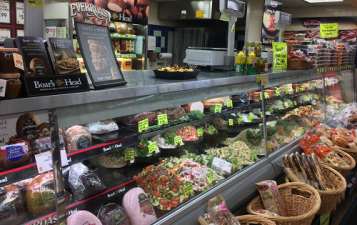Leveraging Prepared Foods to Win Back the Restaurant Customer 9/19/2017
My local grocer, Giant Eagle, is a best-in-class example when it comes to prepared foods, and has a variety of offerings to make planning and preparation of healthy, home-style meals quick and convenient for busy shoppers. For example, its grab and go section has a variety of sandwiches, sides and full meals ready for takeout. It also has weekly meal deals that are either ready to serve or require very little in the way of prep. And for those without families, its Meals for One selection are single-serve heat-and-eat specials for a quick lunch and dinner for one.
In addition, it has a very cool Pick 5 program, in which you can mix-and-match five participating items from one of three departments (meat, frozen and prepared foods) for just $19.99.
These are some of the tactics that suppliers and retailers are using to help win back those shoppers who have defected to eating at restaurants, and were among the topics discussed by attendees at ECRM’s recent Frozen, Deli, Meat, Dairy & Bakery EPPS held in Orlando.
And they are not limited to grocers, either. According to Matt Lally, Manager of Insights & Analytics for Nielsen’s Fresh practice, who presented during the session, channels that traditionally have not had much presence in perishables and prepared foods are now investing heavily in this area. “One in four consumers have purchased some type of perishable product from a convenience store or a dollar store,” he said. (Download the Nielsen slide presentation here).
What’s more, retailers that have invested heavily in these departments are seeing the impact on sales ripple throughout the rest of the store. “Their total food sales have grown at a rate four times faster than at retailers that have not differentiated themselves with investments in the perimeter,” he added.
In other words, rotisserie chicken and pizza no longer cut it; retailers and suppliers must deliver new innovation in prepared foods, and the three key areas of interest among consumers are convenience, ethnic foods, and health and wellness-related products – three areas particularly noted among retailers and suppliers attending the EPPS. For example, one attendee noted that grab-and-go meat and cheese products are popular with consumers, and Millennials in particular are seeking out single-serve items with clean labels. (This is a trend we’re seeing more and more among our various grocery EPPS sessions, such as our Beverage and Snack & Dry Grocery EPPS.)
Convenience
Two key methods of providing convenience, according to Lally, include the optimization of the store layout when it comes to perishables, and the deli in particular, as well as the development of meal solutions. Convenience basically boils down to a savings in time – whether it’s finding what you want and transacting quickly, or else reducing or eliminating the prep work needed for consumption. “When we asked consumers what was the No. 1 advantage of prepared foods versus home cooking, 65 percent said it was convenience,” said Lally. “Maybe I have to heat it up, or maybe it’s already heated, but it goes back to that need for time and speed.”
One way retailers can accomplish this is with the design, layout, and placement of the prepared foods department, such as bringing the department closer to the front of the store so shoppers can grab what they need and leave quickly, or else the addition of checkouts at the prepared foods area specifically for these convenience customers.
Another way is through the development of meal solutions that span categories – like the Giant Eagle example I gave earlier -- and leveraging product adjacencies, such as adding dessert selections next to prepared food offerings. Meal kits – which are becoming increasingly popular among retailers looking to compete against the likes of services like Blue Apron – provide the convenience of assembling all of the items a shopper needs for a home cooked meal, saving them time in the prep work while at the same time giving the sense of accomplishment that making a home-cooked meal provides. “One of the things we learned is that consumers still want to have at least a little hand in the preparation,” said Lally.
Ethnic Foods & Flavors
According to Lally, one in three Americans consume food that contains multicultural flavors at least once a week – something we’ve seen across categories during the course of the year (see The International Cuisine Conundrum). As a whole, multicultural flavored products have increased 16 percent, according to Nielsen, so they definitely present an opportunity to help drive growth in the department.
Two examples Lally provides are guacamole and sushi: “Prepared guacamole has grown 23 percent,’ he said. “Plus, in a two-year span, deli-sushi sales have increased by more than $500 million. It’s no longer something you’ll only find in a premium grocery store; now you can get it at Walgreen’s.”
Wellness
As we’ve seen at ECRM’s other grocery EPPS sessions, wellness continues to be a strong driver of sales and product innovation for food retail.
Indeed, according to Diana Sheehan, a Retail Analyst with Kantar Retail, who also presented at the EPPS, data from Kantar’s Retail Shopper Scope indicate that 62 percent of consumers pay more attention to food labels and ingredients than they used to, and more than half (53 percent) say they are more likely to seek out food and beverages that are minimally processed. And suppliers are addressing this; from 2015 to 2016 there was a 28 percent increase in advertising creative that mention “clean label” attributes, including terms such as “organic,” “no artificial flavors,” “gluten-free,” non-GMO,” “vegan,” and “grass-fed.” (Click here to download the presentation slides.)
According to Sheehan, “Health” and “Wellness” are unique concepts in shoppers’ minds. Health is more related to physical and functional aspects, associated with terms like “eating healthy,” “avoiding processed foods,” and “exercising regularly.” The concept of wellness, on the other hand, is more mental and aspirational, associated in the shopper’s mind with terms like “having hobbies and interests,” “feeling happy with how I look,” and “keeping my mind sharp.”
At the same time, health and wellness are increasingly tied to the concept of sustainability, and health and wellness-minded consumers now think in terms of “good for me,” (products they will consume), “good for you” (products their families will consume), and “good for everyone” (the impact that the production of those products will have on the world).
Retailers and suppliers who address these wellness concepts in their product development and marketing and merchandising strategies will go a long way toward driving more sales in the frozen, fresh and prepared foods departments. And since shoppers are willing to pay more for these cleaner-label foods, they’ll likely increase margins, as well.
So, with a focus on wellness, along with more convenient offerings with a touch of ethnic flavor, we just might be able to convince more shoppers to eat home again.
CLICK HERE TO REGISTER FOR ECRM'S 2018 DELI, DAIRY & BAKERY EPPS


Sarah Davidson is ECRM's SVP of Grocery, and can be reached at 440-542-3033